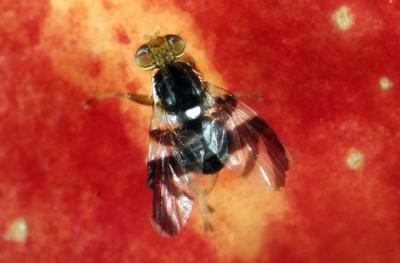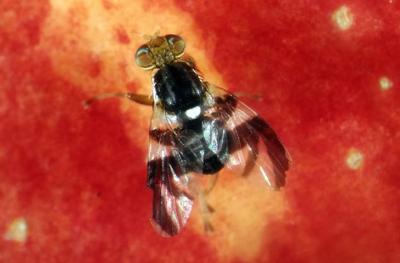
Credit: NCBS-TIFR
"Two months ago, we were congratulating ourselves on a fair crop of winterapples. To all appearance, they were freer from worms than we had known them in this section for years. But, alas! our hopes are again blasted. The apple-maggot seems to be as prolific as ever. Two weeks ago, we overhauled two hundred and fifty bushels of apples that we had gathered and placed in store for winter use; and of that number we threw out fifty bushels, most of which had been rendered worthless; and still the work of destruction goes on. The depredations of the apple-maggot continue, converting the pulp of the apple into a mere honeycomb, and rendering another overhauling soon indispensable."
-An excerpt from the November 1866 issue of "The Circular" of the Oneida Community, published at Wallingford, United States of America as printed in "The Apple Maggot" by B. A. Porter
Roughly 180 years ago, some hawthorn fruit flies in the Eastern coast of North America smelt the fruits on apple trees – a fairly recent import into that region from Europe – and found them attractive. Today, nearly 2 centuries later, the flies have evolved into two distinct 'tribes'. One tribe, called hawthorn flies, prefer to use native North American hawthorn fruit to lay their eggs on, while the other, called apple flies attack crops of domesticated apples. Apple flies are currently one of the greatest pest threats to apple production in Northeast America and Canada.
But how did the split amongst these fruit flies come about?
A clue to how this divergence emerged has now been worked out by scientists from the University of Notre Dame, USA, and the National Centre for Biological Sciences (NCBS), Bangalore. Their study indicates that a minuscule change in the connections of two channels in the brain – one for detecting hawthorn odours and the other for apple odours – could have been a major cause for the switch in host fruit.
Hawthorn flies and apple flies are considered to be two races of the species complex Rhagoletis pomonella. The flies are textbook examples for the process of sympatric speciation, a process by which new species evolve in the same geographic region from a common ancestor species. The two races of flies maintain separate populations on the basis of preferred host fruits, which they detect through smells – apple flies prefer apple scents, while hawthorn flies prefer hawthorn fruit smells.
"Changes in behaviour can lead to the evolution of new species, particularly when these behaviours influence habitat choice. Yet the neural bases for such changes are relatively unknown," says Shannon Olsson, who heads a laboratory on chemical ecology at NCBS and was involved in this study. A major factor that has limited scientists' understanding of how these races could be evolving was a prior inability to study their nervous systems closely.
For the first time, researchers in this study have investigated the differences at a sensory level between two populations in the process of differentiating into distinct species. To gain a neurosensory perspective on how the distinct preferences for apples and hawthorn fruits arose in these flies, the scientists began by examining how nerve cells on the antennae of apple flies and hawthorn flies react to the different fruits' scents.
The team identified 28 classes of nerve cells called Olfactory Sensory Neurons or OSNs that responded to different combinations of odours. Amongst this set, were a small collection of OSNs that responded to key chemicals from apple and hawthorn fruit. Previous studies had identified the two chemicals – butyl hexanoate in apple odours and 3-methyl-1-butanol in hawthorn fruit odours – to be most important in attracting apple and hawthorn flies respectively.
While testing this smaller subset of nerve cells with these chemicals, the researchers found a startling pattern. Just two pairs of OSNs located in the same area of the fly antenna, could be the cause of apple and hawthorn flies' specific preferences.
The results of this study, published in the journal Proceedings of the Royal Society B, essentially suggests that a tiny switch in the wiring of two channels in the brain – one coding for detection of hawthorn odours, and one for apple, could have created a change in host fruit preference. This change in behavioural preference has seeded the beginnings of speciation by keeping apple flies and hawthorn flies as separated populations, isolated from each other.
"Our work is significant in its implication that even for such complex behaviors as host choice, tiny changes in the nervous system can have dramatic effects on a species, even on an evolutionary timescale," says Olsson. "This finding thus has implications beyond evolution for our understanding of the relationships between the brain, behaviour, and animal ecology – especially in the case of native species' response to an introduced, foreign species – a big issue for us in India," she adds.
###
Media Contact
Shannon Olsson
[email protected]
http://www.ncbs.res.in
############
Story Source: Materials provided by Scienmag





